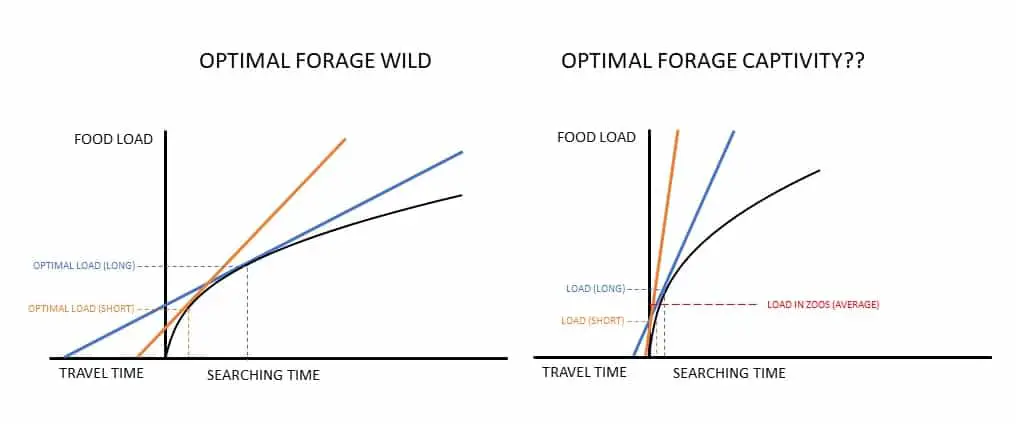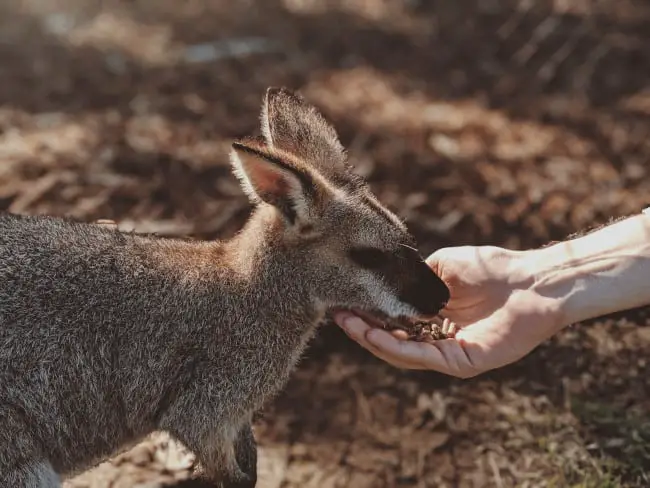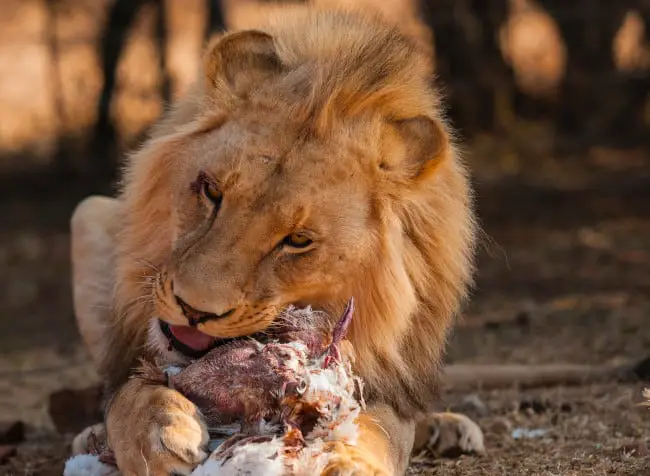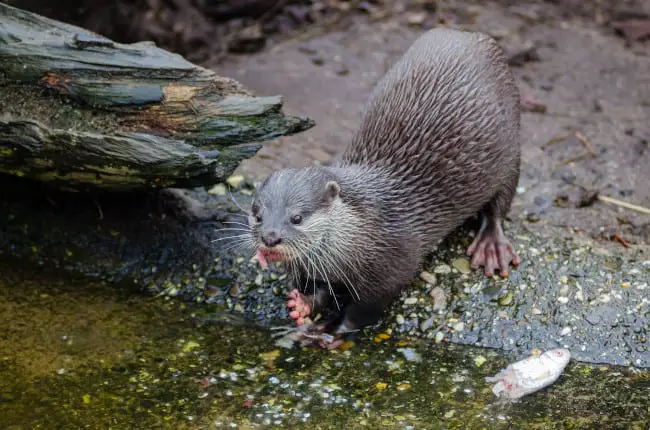Every wild animal has to make the optimal decision when foraging. The best foraging strategy is the balance between energy cost and energy gain within the limitations of the animal and the surrounding, or in other words, the decision that maximises the currency under the constraints of the environment. The decision on foraging strategy is critical for the survival of every animal because when eating provides energy for the animal, the energy cost for foraging must not exceed the energy consumed. These two has to be in balance. The optimal foraging theory model predicts how animals maximise their foraging efficiency and also give valuable insight into managing captive animals.
- What is the optimal foraging theory?
- And how is it in captive environments?
- How to use optimal foraging theory for captive animals
- Decrease pre feeding anticipation and make feeding more unpredictable
- Increase travel and/or search time
- Contrafreeloading: increase the effort an animal has to make
- Adjust food items fitting morphology or physiology of the animal
- Make energy net in a balance between food energy intake and food collection cost
- To conclude
- Further reading
What is the optimal foraging theory?
The optimal foraging theory predicts how an animal will eat and hunt/collect its food. To better understand this theoretical model, we take a look at the four main variables that make this optimal forage equation. The food an animal consumes contains a certain amount of energy. Different food products and different prey items contain varying amounts of energy. To consume these food items will cost handling time which is described as consummatory behaviours. But before an animal can consume food, it first has to search for suitable food items (appetitive behaviour). Some food items cost long search time (think of a search for a large prey item by a tiger), and others have much shorter search time (i.e. finding suitable grass by a zebra). The last variable is the next most profitable food item that can be foraged. These variables complete the equation which determines the foraging decision of animals.
Optimal foraging theory (OFT) is a theoretical model that helps predict how an animal behaves when searching for food and stating that natural selection favours animals whose behavioural strategies maximise their net energy intake per unit time spent foraging
Then there a certain limitation, also called constraints, which limit the foraging of food items an animal can consume and/or hunt. These limitations can be with their morphology or physiology that constraint the intake or chase of some food items. On the other hand, these limitations can also have a geographical nature and tied to the environment of the animal or the outbalance of the net energy of foraging some food items. These limiting factors make it logical why animals eat some things and not others. It also determines what kind of consumer an animal is: a generalist has a generalistic forage strategy and easily adapt its forage strategy with seasons and food availability, whereas specialists are specialised in a specific or narrow range of food items and have more difficulties adapting to short-term changes.

And how is it in captive environments?
The optimal foraging theory is a fascinating topic and makes it more clear how foraging strategies develop within animals. But how about animals that live in captive environments? Is it still applicable to them as well? The short answer is no. When we have a closer look at the different parameters of this model, it will quickly become apparent that animals in captive environments miss particular behavioural challenges within their foraging strategy.
For many animals, the travel time and search time for available food are much more limited than in the wild. Especially when fed in the same way every day, animals know the shortest route to the feeding patches or feeding bowls. In the same way, they don’t have to search for the food items anymore, because they are just waiting to be eaten without any effort. Besides, the food load is for most animals always the same day in day out. Many animals have some variation in diet products, but the amount and load are always the same. Animals don’t have to make choices on which food item is best to pursue and will instinctively choose for the item that has the most net energy. When animals obtain a relatively high net energy gain without making any effort for it, makes it clear why obesity in captive animals is a serious problem. In the wild animals continuously make choices between the effort it takes and energy it gains, so that it is in balance. This balance is often disturbed, or not even present, for animals in enclosed spaces, especially when the animals have nothing to do and therefore don’t use much energy at all.
Furthermore, the expectations and time of feeding are also pretty steady in most facilities, so animals develop behaviours to anticipate the arrival of food. This phenomenon is called pre feeding anticipation (PFA) or food anticipatory activity (FAA) and often express in pacing or begging behaviours. And that is not a strange thing, though. As the model shows, animals are continuous making decision about the optimal forage strategy, and they spend more time to collect all the food they need. When animals do not have to spend that much time on foraging, they will spend this time on other behaviours. It is essential to understand PFA to make well-thought decisions on feeding strategies for captive animals.
Thus, we can conclude that the optimal forage strategy is not directly applicable to captive environments. However, when we better understand forage strategies of their wild counterparts, we can use this information for animals we keep under human care to improve the way we feed them. And with that, improve the overall wellbeing of them.
How to use optimal foraging theory for captive animals
Looking at this theory, you can imagine that foraging time is a significant factor for animals, likewise for animals in enclosed environments. Animals need to spend a particular amount on foraging behaviours. Although there is no optimal foraging theory equation developed for animals in human care, there are significant factors to consider in your feeding strategy. And we, as caregivers, have to make these decisions for them. Because the time spent on foraging is so much more in wild species in comparison with enclosed animals, foraging time in captive facilities should be one of the top priorities to animal caregivers. But when we do not have an equation for optimal forage strategies for captivity, how can we use the optimal foraging theory? What are these major factors to consider when feeding captive animals? Let’s dive into what you can do to match the effort an animal has to make for their food items.

Decrease pre feeding anticipation and make feeding more unpredictable
We talked about it above already, but when you make feeding more unpredictable, it will likely decrease pre feeding anticipation. You can do this in roughly two ways. One way is applying irregular and changing feeding times throughout the week. This way, it can decrease PFA behaviours. But when particular signals alert the animal that food is coming, these behaviours will still be performed and may even increase because it will be reinforced as well. Another way is delivering food on changing times without the presence of a caregiver. This food delivery can be achieved using a timed feeding station. But because this is not an option for every facility, feeding animals at different locations at different times can work pretty well. One example from this is hay nets for elephants: When you fill-up many hay nets in the morning and hang them all up out of reach of the elephants, and randomly they are lowered so the elephants can eat the hay from it will decrease the food predictability. It can also have effects on the next factor: travel and search time.
Increase travel and/or search time
From the model, we saw that travel and search time is almost non-existing in captive animals. Travel time and search time can be increased by randomly change where food is located. Food hiding or food scattering can add travel and search time. It is most effective in larger enclosures where some distances (or height) have to be overcome before the food can be acquired. Do not only think in the available surface of an enclosure. For many animals, you can also use the height of the enclosure to increase travel and search time. For example, within a primate enclosure, you hang up twenty food boxes, but only fill-up randomly two to four of them. The primates will always have to search which box is full. And even when they have found already two boxes filled with food, they always check the other locations if there is food available.
Contrafreeloading: increase the effort an animal has to make
The contrafreeloading concept is to increase the effort an animal has to make to require the food items. See it as the handling time of animals in the wild before they can consume the food item, the so-called appetitive behaviours. Examples are like catching fish, open mussels or oysters, peel certain fruits or nuts, cracking a coconut. Sometimes you can make this kind of behaviour possible for animals in captive environments by offering certain food items (i.e. coconuts or mussels), but often the food that we provide is ready-to-eat, and animals do not spend much time on appetitive behaviours. This means chopping food in convenient pieces is most often not beneficial for the animals. I’ve written more information about why you should or should not chop food items, so if you want to know more about that you definitely have to read the article and related research. Another fact is that how more interesting (= often how tasty the food item is which relates to more energy/sugars) the food item is the more effort an animal wants to make to obtain it. Of course, this makes sense and is logical, because the energy it cost to get the food will be balanced by the energy the animal obtain from the food. Animals have a behavioural need to make an effort to get their food, and therefore it is important to implement this concept in your feeding strategy. If you create your feeding strategy in such a way that it takes at least 4x more time for an animal to get their food, in a way that stimulates natural forage behaviours, you do an excellent job. Read a full article about the contrafreeloading concept, what it means, and how to reduce “free” food for the animals in our care.

Adjust food items fitting morphology or physiology of the animal
Nowadays you’ll see all sorts of pellet foods for almost every animal you can imagine. These pellet products are nutritionally perfect for an animal and contain all needed vitamins and minerals. Also, the energy content is well-balanced, and it looks like a beautiful product. But there are some significant drawbacks. The most crucial flaw is that pellet food is too easy to consume and almost need no foraging behaviour at all. So forage time is reduced to nearly non-existing. Additionally, the digestability is so high that all energy is easily obtained and without the feeling of satiation of an animal, the animal is still “hungry”. But we also have to think about the amount of chewing. With pellets, there is almost no chewing at all. But, likewise, with the chopping of food items reduces the amount of chew behaviour. The conclusion is that food items have to match the morphology or physiology of the animal. It is good practice to feed carnivores or piscivores animals whole prey items. In the case of tigers, this means to feed whole chicken or even (half) a goat. In the case of otters, this means to feed whole fish, crabs or mussels. This way, they use their entire morphological adaptation to consume their food item. With other words, they use their complete mouth/jaw and digestive muscles, all their teeth and even in some cases, their paws or other parts of their body to consume the animal. Of course, the food item has to be adjusted to the normal load range that fits the animal, and you have to take food item availability into account.

Make energy net in a balance between food energy intake and food collection cost
The ultimate goal to implement the optimal foraging theory in captive environments is to balance the energy intake and energy cost. This means that the total food energy provided is in balance with the energy cost to obtain all the food items and perform their normal species-specific behaviours. To give an example: when you offer a whole prey like chicken to a jaguar, it is good practice to hang this food item on a bungee cord so that the jaguar needs to make more effort (in other words use more energy) to obtain it. In this way, you stimulate natural hunting behaviours and balance the energy gain with the energy costs to prevent obesity, but also boredom. For another example, when scattering small nuts for lemurs, they have to search and travel to obtain these items, which take time and cost energy. The way you feed the animal needs to be in balance with the energy you provide your animal.
To conclude
Understanding the optimal foraging theory model for wild animals let you make better decisions in the feeding strategy of the animals in your care. It is good practice to have a critical look and check if 1. The food items are in line with the morphology and physiology of the animal, 2. Are provided in such a way that the net energy is in balance and 3. stimulate natural foraging behaviours and extend foraging times. When developing an enrichment program, these factors have to be translated in a way that encourages foraging behaviours as wild counterparts do as well. It is worthwhile to document the enrichment effort and effect to see if the progress meets the goals you want to achieve. I’ve written a complete article about the evaluation of enrichment and the documentation of it. There are many interesting enrichment ideas to stimulate foraging behaviours, which can as well be found on our Pinterest and Youtube channel. You definitely have to check them out to get more inspiration to extend foraging behaviours to improve the animals’ overall wellbeing.
Further reading
- Foraging opportunity: A crucial criterion for horse welfare? (article)
- Optimal search behavior and classic foraging theory (article)
- Foraging-based enrichment promotes more varied behaviour in captive Australian fur seals (article)
- Tool use task as environmental enrichment for captive chimpanzees (article)
Share this page!